|
by kirupa |
20 August 2007
In the previous
page, you tied your button's Click event to an event handler called Speak.
With that under-the-hood work out of the way, let's focus on adding the code to
make our application speak.
Since a large part of this tutorial is getting the existing
text-to-speech functionality to work, you only have to add a
few lines of code. Unlike previous tutorials where you could
just copy and paste the code, resolve any missing
namespaces, and test your application, this time around you
have an extra step - adding a reference to the namespace
that contains the Speech classes.
To see what I mean, replace all
of the code found inside your
namespace ItSpeaks section with the following:
- public
partial
class
Window1
- {
- private
SpeechSynthesizer
speech;
-
- public
Window1()
- {
- this.InitializeComponent();
-
- // Insert code
required on object creation below this point.
- speech
=
new
SpeechSynthesizer();
- }
-
- private
void
Speak(object
sender,
System.Windows.RoutedEventArgs
e)
- {
- // Speak
- speech.SpeakAsync(textToSpeech.Text);
-
- // 0 to 100
- speech.Volume
=
100;
-
- // -10 to 10
- speech.Rate
=
-2;
- }
- }
Try building your application after having copied and
pasted the above code. When you try to build, you will
receive the following error: The
type or namespace name 'SpeechSynthesizer' could not be
found (are you missing a using directive or an assembly
reference?):
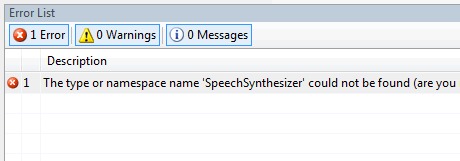
[ you will receiving a missing reference error ]
Normally, you can just right click on your
SpeechSynthesizer class, find the Resolve sub-menu, and add
your missing namespace. When you try that, though, you are
in for a bit of a surprise:
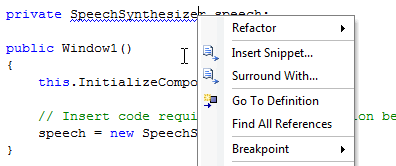
[ oh no - there is no Resolve sub-menu ]
Notice that there is no Resolve menu! In situations like
this, you'll need to add a reference to the namespaces that
contain the class you are looking for. That isn't overly
difficult. The easiest way to determine which class
SpeechSynthesizer belongs to is by searching
MSDN (the huge MS repository of programming information)
for SpeechSynthesizer.
In my search attempt, the very first result provided the
information I needed:
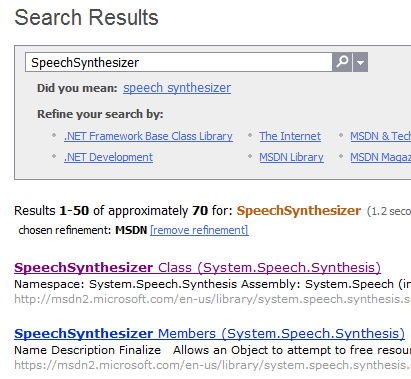
[ the MSDN search results for our SpeechSynthesizer query ]
Notice that the SpeechSynthesizer Class is located in
System.Speech.Synthesis
namespace inside the
System.Speech's system.speech.dll assembly. With this
information, you can discern that you need to add a
reference to something that contains System.Speech.
To add a reference, locate your Solution Explorer in your
Visual Studio / Visual C# window. Find the References
folder, right-click on it, and select Add Reference:
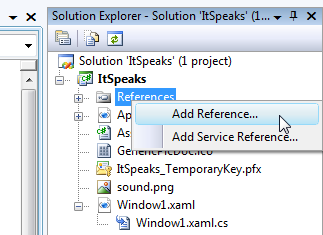
[ right click on the References folder and select the Add
Reference menu item ]
Once you have selected Add Reference, the Add Reference
window will appear. Click on the .NET tab and use the
scrollbar to find the component named
System.Speech:
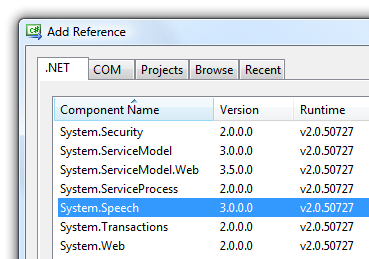
[ add the System.Speech component from the Add Reference
window ]
Once you have found and selected the System.Speech
component, press OK. Your Add Reference window will
disappear, and you will find that your Reference folder in
your Solution now includes a reference to
System.Speech:
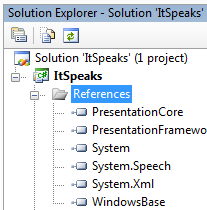
[ System.Speech now appears among your References ]
Simply ensuring your System.Speech reference is added is
not enough. You need to tell your code to use it. In
Window1.xaml.cs - the file that should already been open,
find the list of using
statements towards the top of your code:
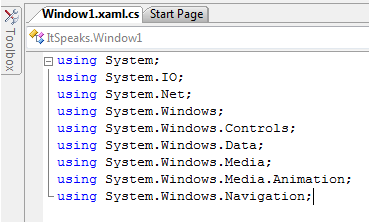
[ your current collection of using
statements ]
It's time to add another using statement. Anywhere in
that list, create a new line and type
using System.Speech. By
doing this, you ensure that your code will use the
System.Speech namespace.
With your System.Speech
namespace now recognized, in your code, right click on any
instance of your SpeechSynthesizer text. Unlike before where
you only saw the Refactor sub-menu, this time you will also
see the Resolve sub-menu appear:
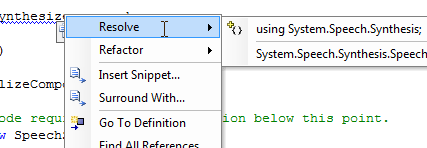
Use the Resolve menu and select the
System.Speech.Synthesis
path. If you try to build your project now, you should not
receive an error. When you test your application, enter some
text, and press the Speak button, you will hear
what you wrote:
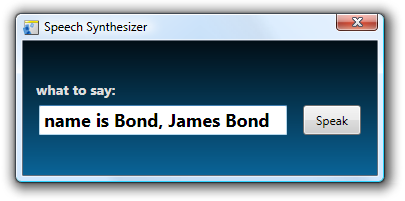
[ enter some text and click on the Speak button to hear text
read aloud ]
We are almost done with the tutorial now. There is just
one minor usability feature that we need to implement. In
this application, to hear what you wrote, you need to use
your mouse and click on the Speak button. Wouldn't it be
more natural to simply use the Enter button after typing
your text? I think so. Let's implement that feature in the
next section.
There are several ways to implement playing back the text
using the Enter button. The most common approach, the one
you are probably most familiar with if you have a background
in other language, is where you have a listener that detects
when the Enter key on your keyboard was pressed. Once the
listener detects the event, it will call the appropriate
method to deal with the Enter key press. In WPF, there is an
easier way when you have just one button.
In WPF, buttons have a property known as
IsDefault. The IsDefault property allows you to
call a button by simply pressing the Enter key. That is just
what we want for our application, so let's set our Speak
button's IsDefault property to true.
To do that, go back to Blend. Select your Speak button
and make sure your button's properties are displayed by
clicking on the Properties button:
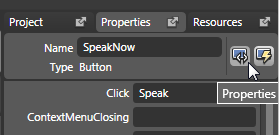
[ click on the Properties button to access your button's
properties ]
Under your button's properties, find the Common
Properties panel. Contained in the Common Properties panel
will be the IsDefault
checkbox. Once you have found the IsDefault checkbox, click
on it to check it:
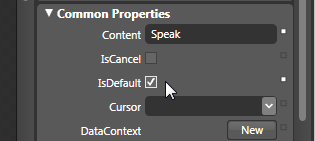
[ check the IsDefault checkbox to set the property to true ]
If you test your application again, type a few words and
press Enter. After you press Enter, you will hear your text
played back audibly. Best of all, you didn't have to move
your hand away from your keyboard to use the mouse to click
on the Speak button like you had to earlier.
Just a final word before we wrap up. If you have a question and/or want to be part of a friendly, collaborative community of over 220k other developers like yourself, post on the forums for a quick response!

|